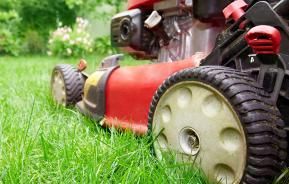
How to cut your grass: step by step
In this section, we’ll break down the actual process of mowing your lawn into individual steps, giving you some lawn mowing tips and tricks.
Step 1: Trim the edges
When it comes to grass mowing tips, the golden rule is to start by mowing the edges of your lawn. Trimming around the lawn gives a sharp edge that is very pleasing to the eye.
Alternatively, edging by hand can help give your lawn boundaries extra definition, and doesn’t take nearly as long as you might think! You can buy a half-moon edging iron, which can be used twice a year – at other times you can use long-handled edging shears to maintain a neat, trimmed appearance.
Step 2: Mow in straight lines
Mow around the borders of your garden first and then fill in the middle. Mowing in straight lines is a generally sensible practice because it enables you to clearly see which areas of the lawn you’ve already tackled and reduces the likelihood of you missing a patch. Of course, it also has aesthetic advantages, especially if you’re cultivating an ornamental lawn.
If you’re wondering how to get lines in your lawn, then it’s essential that you invest in a lawn mower with a rear roller. Rollers flatten the grass after the blades have trimmed it, pushing it in a certain direction, which creates the effect of stripes. When mowing in a straight line – whether for practicality or aesthetics – overlap the lines slightly to make sure you don’t miss any patches.
A top tip for cutting stripes into your lawn is to consider the position of the sun and how it passes over your garden. The stripe effect is caused by light and shadow – the reflection of light on the grass, depending on which way it’s pointing. To make the most of this, try to cut in like with the path of the sun over your garden, rather than cutting across its path.
If you have an irregularly shaped lawn, start with a line across the middle, then mow one side at a time. This will help reduce the likelihood of you veering off course. If you have recently sowed areas of the lawn, you should avoid mowing these until the grass has bedded in.
Step 3: Compost your clippings
Don’t forget to regularly empty your lawn cuttings bags to prevent a build-up of material around the mower blades. It’s also a good idea to rake the lawn regularly when you’re cutting to make sure you don’t miss any patches of grass.
Clippings can be composted (between layers of woodier material) or deposited in small piles around the garden. This can help encourage wildlife, such as earthworms, which enhance your garden’s ecosystem.
How to cut overgrown grass
If you’ve let your lawn get a bit out of shape, don’t worry – it happens to us all from time to time! You’re likely wondering how to cut overgrown grass when the standard advice for mowing your lawn is not to remove more than a third of the length of the grass at a time, and the answer is that you may have to cut it multiple times to reduce the growth. Leave a few days between each cut for the grass to recover – particularly if it’s outside of summer.
If you’re short on time and really can’t justify multiple mows, then you can usually get away with cutting your grass back by two-thirds – as long as it’s just a one-off and you don’t do it multiple times. Making a habit of it can cause unnecessary stress to your lawn.
Sharpen your mower blades
Have the blades of your lawn mower sharpened at least once a year. Blunt lawn mower blades can cause substantial damage to your lawn because they rip the grass instead of cutting it. This results in blades of grass that turn white at the tips and become more prone to lawn diseases.
Grass mowing tips
For more grass cutting tips and tricks, check out our video tutorials for how to achieve a great looking lawn on our YouTube channel here.









